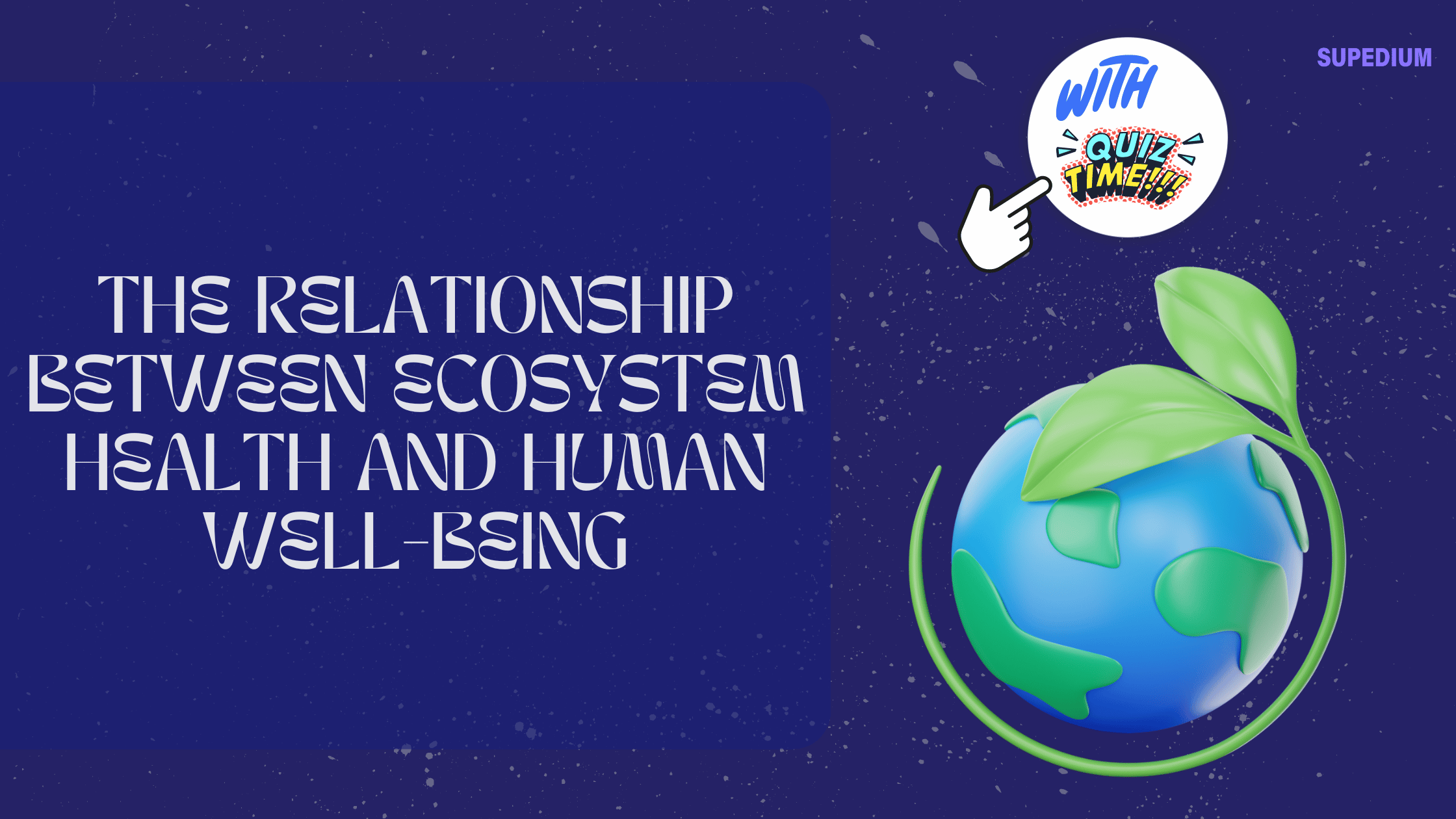Table of Contents
![]()
Introduction
Ecosystem Health is a term that encompasses the condition of ecosystems, focusing on their biodiversity, functionality, and resilience. Healthy ecosystems are characterized by high species diversity, robust ecological processes, and the ability to withstand environmental changes.
Human Well-being refers to a broad range of factors including physical health, mental and emotional health, and overall economic and social stability. Understanding the relationship between ecosystem health and human well-being is crucial because these two systems are intricately linked. Effective management of ecosystems not only preserves natural environments but also enhances human quality of life.
Components of Ecosystem Health
Biodiversity is a critical component of ecosystem health. It includes:
- Species Diversity: The variety of species in an ecosystem.
- Genetic Diversity: The genetic variation within species.
- Ecosystem Diversity: The range of different ecosystems within a region.
Ecosystem Services are the benefits that ecosystems provide to humans, which include:
- Provisioning Services: Such as the supply of food, fresh water, and medicinal resources.
- Regulating Services: Such as climate regulation, water purification, and disease control.
- Supporting Services: Such as nutrient cycling and soil formation, which are essential for sustaining other ecosystem services.
- Cultural Services: Such as recreational opportunities, aesthetic value, and spiritual significance.
Ecosystem Dynamics involve the flow of energy and nutrients through ecosystems and their ability to maintain stability and resilience. These dynamics are crucial for sustaining ecosystem health and, by extension, human well-being.
Impacts of Ecosystem Health on Human Well-being
Direct Impacts of ecosystem health on human well-being include:
- Health Benefits from Natural Environments:
- Physical Health: Access to natural environments is linked to reduced rates of cardiovascular disease and improved immune function. Activities such as hiking and outdoor sports contribute to physical fitness.
- Mental Health: Interaction with nature can reduce stress, anxiety, and depression. Natural settings provide a sense of tranquility and improve mood.
- Provision of Resources:
- Food Security: Ecosystems provide vital resources such as fish, fruits, and vegetables. Sustainable management ensures continued availability of these resources.
- Clean Water: Healthy ecosystems like wetlands and forests play a crucial role in filtering and regulating water supplies.
- Medicine and Therapeutic Plants: Many pharmaceuticals are derived from plants and animals in natural ecosystems. Protecting biodiversity ensures the continued availability of these resources.
Indirect Impacts include:
- Economic Benefits:
- Sustainable Livelihoods: Many communities rely on ecosystem services for their livelihoods, such as fishing and agriculture. Sustainable practices ensure long-term economic stability.
- Ecosystem-based Tourism: Natural attractions such as national parks and wildlife reserves generate significant economic revenue and employment opportunities.
- Social and Cultural Benefits:
- Community Cohesion: Shared access to natural spaces can strengthen community ties and foster cooperation.
- Cultural and Spiritual Values: Many cultures hold natural landscapes and species in high spiritual regard, which contributes to a sense of identity and heritage.
Ecosystem Services and Quality of Life vary between urban and rural settings. Urban green spaces offer health benefits and improve quality of life for city dwellers, while rural communities often depend directly on natural resources for their livelihoods.
Threats to Ecosystem Health
Pollution is a significant threat to ecosystem health, including:
- Air Pollution: Emissions from industries and vehicles can damage vegetation and disrupt atmospheric processes.
- Water Pollution: Contaminants from agricultural runoff and industrial discharges can harm aquatic life and compromise water quality.
- Soil Contamination: Use of pesticides and other chemicals can degrade soil health, affecting plant growth and food security.
Habitat Destruction includes:
- Deforestation: The clearing of forests for agriculture or development reduces biodiversity and disrupts local climates.
- Urbanization: Expansion of urban areas encroaches on natural habitats, leading to habitat loss and fragmentation.
- Land Degradation: Overuse of land for farming or mining can lead to soil erosion and reduced fertility.
Climate Change poses a threat through:
- Altered Weather Patterns: Changes in temperature and precipitation affect species distributions and ecosystem functioning.
- Ocean Acidification: Increased CO2 levels lead to more acidic oceans, impacting marine life such as corals and shellfish.
- Impact on Species Distribution: Shifts in climate can force species to migrate or adapt, often resulting in ecosystem imbalances.
Overexploitation of Resources involves:
- Overfishing: Depletes fish stocks and disrupts marine ecosystems.
- Unsustainable Agriculture: Practices such as monoculture and excessive use of fertilizers can degrade soil and reduce biodiversity.
- Wildlife Trade: Illegal trafficking of animals and plants threatens species with extinction and disrupts ecological balances.
Case Studies
Tropical Rainforests are critical for climate regulation and biodiversity. They support numerous indigenous communities whose cultures and livelihoods are deeply connected to these forests. Conservation efforts are essential to preserve both the forests and the cultures that depend on them.
Coral Reefs are among the most diverse ecosystems on Earth, providing habitat for countless marine species and supporting coastal economies through tourism and fishing. However, coral reefs are threatened by climate change and pollution, which can lead to coral bleaching and ecosystem collapse.
Urban Green Spaces offer numerous benefits to city residents, including recreational opportunities and improved mental health. Challenges include balancing development with conservation and ensuring equitable access to these spaces for all residents.
Strategies for Enhancing Ecosystem Health and Human Well-being
Conservation Efforts are crucial and include:
- Protected Areas: Establishing national parks and reserves to safeguard critical habitats.
- Wildlife Conservation Programs: Initiatives to protect endangered species and restore populations.
Sustainable Development Practices focus on:
- Sustainable Agriculture: Practices that enhance soil health and biodiversity while maintaining productivity.
- Green Building and Urban Planning: Designing infrastructure to minimize environmental impact and promote sustainability.
Policy and Governance involve:
- Environmental Regulations: Enforcing laws that limit pollution and protect natural resources.
- International Agreements: Agreements such as the Paris Agreement aim to address global environmental issues collaboratively.
Community Engagement and Education are essential for:
- Public Awareness Campaigns: Educating the public about the importance of ecosystem health and sustainable practices.
- Citizen Science Initiatives: Encouraging community involvement in monitoring and protecting ecosystems.
Future Directions and Research
Emerging Technologies are enhancing our ability to manage ecosystems, including:
- Remote Sensing and Monitoring: Technologies that allow for real-time tracking of environmental changes and ecosystem health.
- Restoration Ecology: Techniques for restoring degraded ecosystems and enhancing their functionality.
Integrating Ecosystem Health into Public Health Policies involves:
- Health Impact Assessments: Evaluating how changes in ecosystems affect public health.
- Ecosystem-Based Management Approaches: Managing ecosystems in a way that considers the health of both natural and human systems.
Building Resilience to Future Challenges requires:
- Adaptive Management Strategies: Flexibility in management practices to respond to changing environmental conditions.
- Strengthening Ecosystem Services in a Changing Climate: Ensuring that ecosystems continue to provide essential services despite climate changes.
Conclusion
In summary, the health of ecosystems is fundamentally linked to human well-being. By preserving and enhancing ecosystem health, we ensure that vital services and resources continue to support physical health, mental well-being, and overall quality of life. Collective efforts, informed by research and guided by sustainable practices, are essential for maintaining this delicate balance. As we face future challenges, a vision of integrated management and resilient ecosystems will be crucial for a thriving humanity.






Be the first to comment